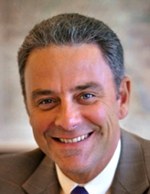Note: This story was last updated at 1:19 p.m.
John Eschenberg, federal project director for the proposed Uranium Processing Facility at the Y-12 National Security Complex, announced Monday that he’s retiring from federal service on May 30.
Eschenberg said his decision to leave federal service is driven by a desire to “focus on new career opportunities in the private sector and to further my focus on serving nonprofit organizations.” Eschenberg said he is heavily involved with the Emory Valley Center (an institution for the developmentally and intellectually disabled) and its plan to start construction of a new facility in Oak Ridge later this fall.
Eschenberg has been the federal project director of the Uranium Processing Facility for almost three years, and he has been in Oak Ridge nearly six. He has served under six different U.S. Department of Energy secretaries, in five different states, and in all of its major programs, Eschenberg said in an email announcement obtained by Oak Ridge Today.
Eschenberg said there is never a perfect time for a transition of key leadership roles, but “given the project’s stability, now feels like the optimum time to me.”
He said Dale Christenson, who has been serving as the deputy federal project director for almost five years, will serve as acting federal project director during the process to formally hire a replacement.
“(Christenson) has impeccable credentials, unmatched knowledge, and a proven track record of project deliveries,” Eschenberg said. “Dale…clearly is a strong candidate for taking the position permanently.”
Eschenberg said his family plans to maintain a primary residence in Oak Ridge, with one son a student at Maryville College and the other a student at Oak Ridge High School.
The UPF is the largest DOE investment in Tennessee since World War II. It’s also the largest ever-construction project for the National Nuclear Security Administration, a separately organized DOE agency that oversees work at Y-12 and other sites such as the Pantex Plant in Amarillo, Texas.
The UPF would replace aging World War II-era buildings at Y-12, the hub of the nation’s uranium processing operations. It’s expected to be completed by 2025 and cost no more than $6.5 billion.
Federal officials celebrated what they called the first milestone on the project in March: the completion of site readiness work, delivered on time and under budget. The work included the relocation of Bear Creek Road, a new bridge, and construction of a haul road.
“I would point out that although the journey hasn’t been always been easy, we have remained true to our principles to mature process technologies, drive the design to 90-plus percent completion before starting nuclear construction, and to satisfy our top-line project cost objective by really being honest with ourselves to understand what can be built for $6.5 billion,” Eschenberg said in the Monday announcement. “We are steadfast in our direction to initiate early site preparatory activities to enable out-year construction of a three-building complex with a strategy to tailor safety and security requirements. Although many challenges remain, our approach, our team, and our leadership are completely aligned for success.”
The UPF was originally envisioned as one building, but that approach changed after a Red Team review led about a year ago by Oak Ridge National Laboratory Thom Mason. The idea is to segregate work by its hazard and security challenges, recognizing that the cost per square foot can vary.
In March, Eschenberg said the project now includes a mechanical and engineering building, a salvage and accountability building, and a main processing building.
“Our alignment for success is quite evident, now having been independently affirmed by both a second Red Team review and a Peer Review Team,” Eschenberg said in the Monday announcement. “Beginning with last summer’s contract award to enable the separation of design and construction activities from the day-to-day plant and manufacturing operations, our team has moved to adopt a more efficient commercial approach to project execution. The merits of that approach are now beginning to be realized. Of course, much credit is owed to the leadership in the National Nuclear Security Administration for remaining committed to overhauling its approach to managing large capital asset projects over the last three years and to our partners in Consolidated Nuclear Security LLC.”
CNSÂ manages and operates Y-12 for the NNSA.
In March, federal officials said UPF design work continues, and they expect it to be 90 percent complete by Fiscal Year 2017. UPF construction won’t start until the design is 90 percent complete, and the baseline cost won’t be set until then.
“I have had some time to reflect on nearly six years in Oak Ridge and the changes we have seen during that time,” Eschenberg said. “It began with progress enabled by the American Recovery and Reinvestment Act bonanza, generating hundreds of jobs and allowing the reservation to significantly advance it’s environmental cleanup objectives. It continued with an unwavering commitment to transform and modernize both the Oak Ridge National Laboratory and the Oak Ridge National Security Complex. While we have seen many of our prime contractors change and a wholesale restructuring of federal leadership, one element that remains consistent is the universal recognition of the significance we provide to our nation through the advancement of science, national security missions, and by repurposing our assets to expand commercially-driven economic vitality. This progress is unmatched—anywhere.”
More information will be added as it becomes available.

Leave a Reply